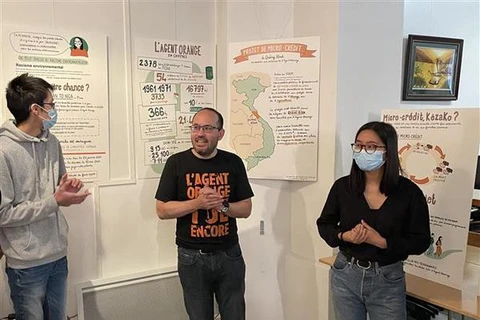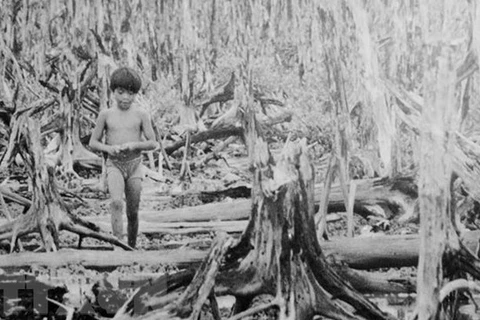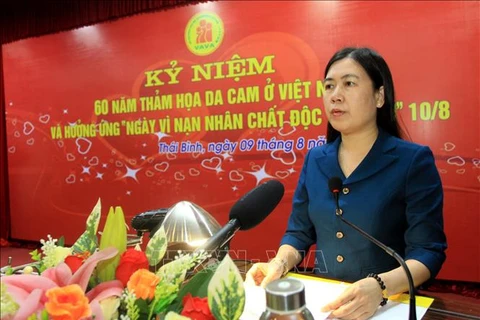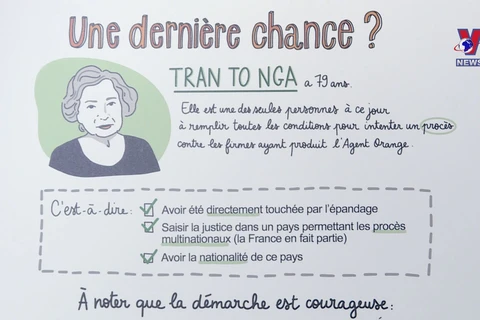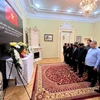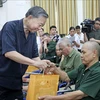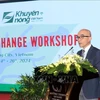 Victims of AO/dioxin joined a vocational course at an establishment in Thanh Khe district of Da Nang in 2015 (Photo: VNA)
Victims of AO/dioxin joined a vocational course at an establishment in Thanh Khe district of Da Nang in 2015 (Photo: VNA) Hanoi (VNA) – Vietnam is home to about 75,000 second-generation victims of Agent Orange (AO)/dioxin and 35,000 others of third generation. Some localities even have victims in the fourth generation.
2021 marks the 60th year since the US army began to drop tens of millions of extremely toxic chemicals on various areas across Vietnam. Although it has been nearly half a century since the war ended in 1975, its remnants still linger in families of those who returned from the battlefields. The aftermath caused by AO/dioxin even extends across three generations in many families.
The Party, State and people have over the years paid due attention to supporting AO/dioxin victims so as to help ease their hardships.
Sixty years ago, on August 10, 1961, the US sprayed herbicide containing dioxin, an extremely toxic chemical, on various areas across Vietnam’s southern region, starting its chemical warfare in the country with an aim to eliminate forest cover and crops for the north and revolutionary troops. It was a chemical warfare of the largest scale, which lasted for the longest time and caused the most devastated consequence in world’s history.
During 10 years until 1971, the US army dropped about 80 million litres of herbicide, of which AO made up 61 percent and contained roughly 366kg of dioxin which is among the most potent toxins known to mankind.
According to documents unveiled by the US Department of Defence, over 434,000 gallons of AO containing about 11kg of dioxin were sprayed in A Luoi area of the central province of Thua Thien-Hue between 1965 and 1970.
The chemical caused negative long-term impacts to the environment, ecosystem and people’s health.
Due to huge and severe consequences of chemical warfare in Vietnam, in 2009, the World Peace Council (WPC) named August 10 as International Day of AO victims.
Even though it has been 60 years, the pains linger on for families of the victims. Up to 4.8 million Vietnamese were exposed to the chemical, and over 3 million became its victims.
Incomplete data showed that there are about 75,000 second generation victims of AO/dioxin and 35,000 others of third one. Some localities even have victims in the fourth generation.
A huge cost is needed for nursing and treatment for victims, therefore, most of the families live in poverty with their children suffering from disabilities.
Over the years, the Vietnamese Government has mobilised resources and worked together with organisations and individuals at home to build welfare policies for AO/dioxin victims in Vietnam in a bid to ease their difficulties. Some organisations and units have been set up to assess and devise plans for overcoming consequences of the chemical, such as the National Committee for Research into Agent Orange (Committee 10-80), the National Steering Committee for overcoming the consequences of toxic chemicals used by the US in the war in Vietnam ( Committee 33) and the Vietnam Association for Victims of Agent Orange/Dioxin (VAVA).
In May 2015, the Party Central Committee Secretariat issued a directive on enhancing Party leadership in addressing consequences of toxic chemicals used by the US during the war in Vietnam.
Alongside the implementation of the directive, communication work has been bolstered so that people at home and abroad understand more about the AO/dioxin disaster.
A sum of more than 10 trillion VND (438.23 million USD) from the State budget is earmarked each year for AO/dioxin victims and hard-hit areas. Over 320,000 people engaged in the revolution and their offspring victimised by the chemical are recognised as those who rendered services to the nation and eligible for preferential policies.
To date, Vietnam has 12 villages offering shelters and care for children with disabilities and AO/dioxin victims.
 Ly Quang San (L), residing in Kon Tum, is nearly 70, he still has to take care of his children and grandchildren as they are all AO/dioxin victims (Photo: VNA)
Ly Quang San (L), residing in Kon Tum, is nearly 70, he still has to take care of his children and grandchildren as they are all AO/dioxin victims (Photo: VNA) On the occasion of the “Day for Vietnamese Victims of AO/dioxin”, President Nguyen Xuan Phuc expressed his sympathies to the victims nationwide.
He affirmed that the Party, State and people always pay heed to and support AO/dioxin victims, wishing them to overcome diseases and difficulties.
According to Hatfield Consultants, West Vancouver Canada, as many as 28 “hot spots” remain in Vietnam’s southern region which could affect the environment, ecosystem and human, including heavily-polluted sites like the airports of Da Nang; Bien Hoa in Dong Nai; Phu Cat in Binh Dinh and A So in Thua Thien-Hue./.


